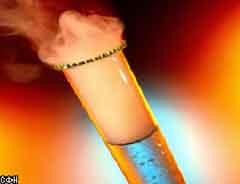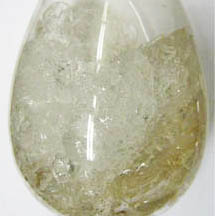Sulfuric acid

Sulfuric acid H2SO4 - one of the strongest dibasic acids. In the diluted state it oxidizes almost all metals except gold and platinum. It reacts intensively with non-metals and organic substances, turning some of them into coal. When preparing a solution of sulfuric acid, it is always necessary to pour it to water, and not Vice versa, in order to avoid spraying acid and boiling water. At 10 °C solidifies, forming a transparent vitreous mass. When heated 100% sulfuric acid easily loses sulfuric anhydride (sulfur trioxide SO3) up until its concentration will not reach 98 %. In this state it can be used in laboratories. In a concentrated (anhydrous) sulfuric acid is a colorless, fuming in air (due to fumes), oily liquid with a characteristic odor (T boiling point=338 °C). It is a very strong oxidizer. This substance has all the properties of acids:
Chemical properties of sulfuric acid
- chemical reaction with metals:
H2SO4 + Fe → FeSO4 + H2;
2H2SO4 + Cu → CuSO4 + SO2 +2H2O - in this case, the acid is concentrated.
- chemical reaction with metal oxides:
H2SO4 + CuO → CuSO4 + H2O
The resulting solution is blue - CuSO4 - copper sulfate solution. Sulfuric acid is also called oil of vitriol, as in reactions with metals and their oxides form sulfate. For example, in a chemical reaction with iron (Fe) - formed light green solution of iron sulfate.
- chemical reaction with bases and alkalis (or neutralization reaction)
H2SO4 + 2NaOH → Na2SO4 + 2H2O
- chemical reaction with sulfur (acid is concentrated, reaction with heating):
2H2SO4 + S → 3SO2 + 2H2O
- chemical reaction with salts (for example, with washing soda Na2CO3):
H2SO4 + Na2CO3 → Na2SO4 + CO2 + H2O
Production of sulfuric acid

Sulfuric acid is producted with oxidizing sulfur (S) at first to sulfur oxide (sulfur dioxide SO2), and then oxidation of sulfur dioxide to sulfur trioxide (sulfurous anhydride SO3) (left picture):
S + O2 → SO2
- sulfur dioxide - with a suffocating
smell of sulfur.
SO2 + O2 → SO3. This chemical reaction takes place on a catalyst (vanadium oxide V2O5). Substance SO3 - sulfurous anhydride - very hygroscopic crystalline transparent substance, greedily absorbing water and form sulfuric acid:
SO3 + H2O → H2SO4
Sulphurous acid
Sulphurous acid - or Н2SO3 - this is the name of an aqueous solution of sulfur oxide (SO2) in water. In fact, such a chemical does not exist, it is used only for the convenience of compiling chemical reaction equations.
Solution SO2 in water, has an acidic environment. This solution has all the properties of acids, including neutralization reaction.
СSulphurous acid (or it is more correct - solution of sulfur dioxide in water), forms two types of salts: sulfites and hydrosulfites . These salts are reducing agents.
Н2SO3 + NaOH → NaНSO3 + Н2O - this reaction takes place with an excess of sulfurous acid
Н2SO3 + 2NaOH → Na2SO3 + 2Н2O - and this reaction takes place with an excess of caustic soda
Sulfurous acid has a whitening effect. We all know that similar action has chlorine water. But the difference is that, unlike chlorine, sulfur dioxide does not destroy dyes, but forms unpainted chemical compounds with them.
In addition to the basic properties of acids sulfurous acid is capable of discoloring the solution potassium permanganate according to the following equation:
5Н2SO3+2KMnO4 → 2 Н2SO4 +2MnSO4+K2SO4+Н2O
In this reaction, a pale pink solution with consisting of potassium sulfates manganese is formed. The color is due to manganese sulphate.
Sulfurous acid is able to discolor bromine.
Н2SO3 + Br2 + Н2O → Н2SO4 + 2HBr
In this reaction 2 strong acids are formed: sulfuric and bromine.
If you keep the sulphurous acid with access of air, the solution is oxidized and transformed into sulfuric acid
2Н2SO3 + O2 → 2Н2SO4